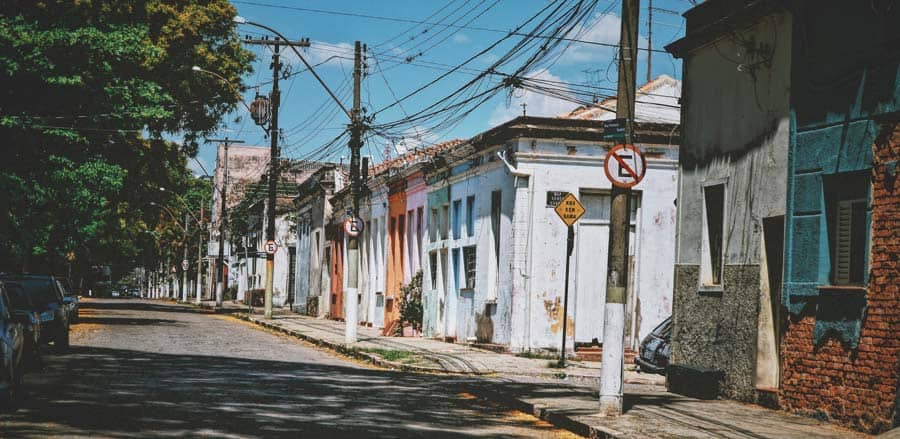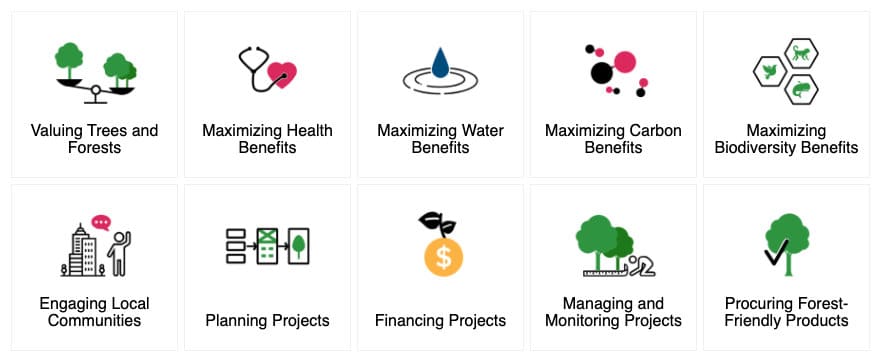Why Care About Trees in Cities?
Forests provide tremendous benefits to urban areas such as clean air and water, climate resilience and biodiversity, human health and well-being. They also provide jobs, recreation, and a suite of nature-based solutions for city infrastructure, argues the international alliance Cities4Forests.
Cities4Forests supports cities around the world to recognise their interdependence with the world’s forests, and use their own political, economic, and cultural power to ensure forest health and vitality. Examples from Campinas, Brazil, and Mérida, Mexico, illustrate how cities can contribute to preserve and extend urban forests.
Campinas – One of the Most Resilient Cities in the World
Campinas was the first municipality to receive the UN certification for resilient cities and has also moved from the 220th to the 7th position in only six years in the state ranking of sustainable cities. How did they do this?

Campinas, Brazil © Feliphe Schiaroll/Unsplash
The city was once called the ‘Princess of the West’ mainly because it was the productive centre of the region – rich in citrus, coffee, and sugarcane plantations. It also became an industrial hub where foundries, factories of machine parts, various machinery, and textile mills flourished and continue to this day. One remnant of the original boom is a 130,000 square metre quarry called Praça Ulysses Guimarães, which was transformed into a park in 1994. The city invested USD 1.3 million in 2013 and a year of work to add more trees, playgrounds, sports grounds, kiosks, a skateboard area, and an event space that is now an added green space for the residents of Campinas.
Moreover, Campinas has developed numerous environmental plans and studies, including ones on basic sanitation, green areas, water resources, environmental education, and a greenhouse gas inventory. Together, their results pointed Campinas in the direction of establishing programmes for forest management, biodiversity enhancement, and green infrastructure implementation (such as linear parks and wildlife passages), among others. Examples of newly established infrastructures are, for instance, 190 kilometres of cycle paths, 14 electric buses in the municipal fleet, 30 hectares of new parks for the population, and 1 million planted trees.
With the commitment of the government, the partnership of the private sector, and through the transparency of information that allows for monitoring and the participation of the population in the implementation of these actions, Campinas’ work has stood out in the international community.
How to Quantify the Benefits of Trees?
Mérida, a city in Mexico’s lush Yucatán Peninsula, is home to 2.3 million trees, which cover over 20 per cent of the metropolitan area. Mérida’s officials know that these trees provide benefits to the residents, but until recently they didn’t know how much these benefits were worth or how they were distributed across the city. That made it difficult for the officials to know where to focus their limited budget and to advocate for more resources.

Mérida, Yucatán, México © Joaquín Martínez Rosado/Wikimedia Commons CC-SA 4.0
Thankfully, there’s a tool for this named i-Tree Eco. It is a free tool that quantifies the climate, health, and water benefits that trees and forests provide to cities by using a rigorous sampling and data collection process. It can assess forest structure, including composition and species diversity. Moreover, it can forecast future benefits while accounting for planting efforts, extreme weather, and annual mortality rates. The outcome of the data analysing tool is a report with estimation of urban forest structure, potential pest impacts, monetary values of trees, ecosystem services and benefits, forecasting of forest structure, and benefits.
For Mérida, the analysis found that its trees sequester over 16,000 tons of carbon each year. In other words, these 2.3 million trees offer a carbon value of USD 648 million to the city. Based this report, Mérida prioritised three main steps:
- Intensify the urban reforestation programme in quantity, quality, tree species selection, and size of trees used.
- Implement a programme to improve the health of smaller trees.
- Better regulate tree removal in new development projects.
Tools like i-Tree Eco provide a unique opportunity for city leaders to ground their policies, plans, and investment decisions in local scientific analysis. Yet, many cities in Latin America, Africa, and Asia often lack access to tools regularly used in Europe and North America. Tools can be expensive, or the data needed to run the tools may be unavailable for the area of interest. Sometimes the challenge is simply knowing which of the hundreds of tools best fit cities’ needs.
Introducing the Cities4Forests Toolbox
Through extensive research, consultations with experts, and discussions with tool developers, the Cities4Forests initiative compiled 32 of the best tools to help cities include forests, trees, and green infrastructure in their decision-making, planning, and investments. The Cities4Forests Toolbox covers a range of topics, from valuing trees and forests, to maximizing key benefits (such as biodiversity, health, water, and carbon), to planning and managing forest-related projects inside and outside their boundaries. Most importantly, these tools are highly recommended, internationally available, low or no cost, and accessible to non-experts and experts alike.

The Cities4Forests toolbox is broken down into searchable topics © Cities4Forests
Moreover, the network Cities4Forests provides technical assistance to align local policy, shared knowledge, peer-to-peer learning and communication activities in order to help cities take climate action together.
For instance, in Mérida, where city officials were already familiar with i-Tree, Cities4Forests helped strengthen long-term capacity by training municipal staff to use the tool and confidently measure progress around their recommended action steps. Similarly, Cities4Forests is working with cities in Indonesia, India, and Madagascar to start monitoring urban tree cover using a tool called Collect Earth where participants use satellite imagery to quantify vegetative cover.
Look out of the window now and spot a tree. When you know what to look for, you can see the impressive positive impact they have on city-dwellers’ lives. Every city, and our collective future, depends on healthy forests around the world. It is time for cities and their residents to join the global effort to conserve and restore forests – inside and outside city boundaries.
- Why Care About Trees in Cities? - 2. April 2020
